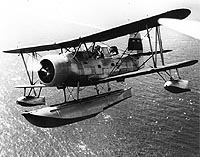
The biplane SOC was designed mainly as a catapult-launched floatplane, flying from battleships for gunfire observations, and from cruisers as a scout. It was capable of flexible employment, with folding wings allowing more planes to fit in cruisers' small hangars and a float that could be exchanged for wheeled landing gear, facilitating operation from aircraft carriers and shore bases in a utility role. Powered by a Pratt & Whitney R-1340 single-row radial engine and fitted with leading edge slats and flaps on the upper of its two wings, it had good low-speed flight charactistics, well-suiting it for catapult operation and short-distance landings in the relatively smooth-water "slick" that a turning ship could create on the open sea.
First ordered in 1933 and flown a year later, the SOC entered service in late 1935 and had superseded the Fleet's earlier shipboard floatplanes by the end of the decade. With production completed in 1938, its ageing design was then nearly ready for replacement by newer medium-powered monoplane types. By late 1941, battleships generally carried the Vought OS2U, whose non-folding wings were not required on the hangarless "battlewagons". It was expected that cruisers would soon get the Curtiss SO3C, which had folding wings. However, the latter aircraft was never quite satisfactory, requiring the SOC to serve on board first-line cruisers until quite late in World War II, when the high-performance Curtiss SC became available. Thus, at a time when massive wartime aircraft production allowed rapid turnover among combat units' aircraft inventories, the elderly SOCs were "nursed" along, credibly performing their vital gunfire observation and limited-range scouting missions well beyond their expected lifespan. A few even served in the post-war Navy.
The SOC started out as the XO3C-1, but was redesignated in mid-1935 when the observation and scouting roles were merged. The initial 135 SOC-1 models were followed by 40 SOC-2s, intended for land operation, 83 SOC-3s and 64 SON-1s, a version of the SOC-3 that was produced by the Naval Aircraft Factory. As the Navy's wartime need for more SOCs became critical, three SOC-4 types were obtained from the U.S. Coast Guard. A notable variant, designated SOC-2A and SOC-3A, featured arresting gear. Several of these were included in the initial air group of the prototype U.S. escort carrier, USS Long Island (AVG-1). In 1941, when the Navy adopted so-called "popular" names to supplement its alpha-numeric aircraft designations, the SOC came to be called the "Seagull", an appropriate nickname for a particularly elegant aircraft.
SOC-3 floatplane characteristics:
This page features views of Curtiss SOC "Seagull" scout-observation planes in flight. It also provides links to a broad selection of our other pictures of this type of aircraft.
For further views of SOC aircraft, see:
| If you want higher resolution reproductions than the digital images presented here, see: "How to Obtain Photographic Reproductions." |
Click on the small photograph to prompt a larger view of the same image.
|
Photo #: 80-G-5885 Curtiss SOC-1 scout-observation aircraft (Bureau # 9979) In flight, 2 July 1939. Official U.S. Navy Photograph, now in the collections of the National Archives. Online Image: 88KB; 740 x 605 pixels Reproductions of this image may also be available through the National Archives photographic reproduction system. |
 |
|
Photo #: NH 80523 Curtiss SOC-3 scout-observation floatplane In flight, soon after delivery to Observation Squadron Two (VO-2B), 1938. The plane is assigned to USS California (BB-44). Note the "Winged Pelican" VO-2 insignia on the aircraft, .30 caliber machine gun in its after cockpit and extended leading-edge slats on the upper wing. Courtesy of Howard F. Ailes, 1974. U.S. Naval History and Heritage Command Photograph. Online Image: 62KB; 740 x 580 pixels |
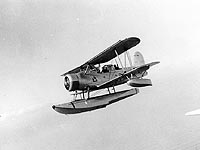 |
|
Photo #: NH 82466 Curtiss SOC-3 scout-observation floatplanes, from USS Honolulu (CL-48) Fly in a formation, circa 1938-39. They are part of Cruiser Scouting Squadron 9 (VCS-9). These planes' Bureau #s are (from left to right): unidentified; 1073; 1175 (a SON-1 variant of the SOC-3); and 1087. Collection of Rear Admiral Samuel Eliot Morison. U.S. Naval History and Heritage Command Photograph. Online Image: 73KB; 740 x 600 pixels |
 |
|
Photo #: NH 97593 Marshall and Gilbert Islands raid, February 1942 A U.S. Navy SOC "Seagull" floatplane flies over Wotje Atoll, during the attack on the Japanese airfield there by gunfire from USS Salt Lake City (CV-25) and USS Northampton (CA-26)) and fighters from USS Enterprise (CV-6), 1 February 1942. The original picture caption identifies the burning facilities as an ammunition dump and two fuel dumps. Official U.S. Navy Photograph, from the collections of the Naval History and Heritage Command. Online Image: 100KB; 740 x 595 pixels |
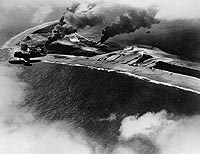 |
|
Photo #: 80-G-68056 Curtiss SOC "Seagull" scout-observation aircraft In flight, just after it was catapulted from USS Augusta (CA-31), in Casco Bay, Maine, June 1942. The plane is armed with two depth bombs. Official U.S. Navy Photograph, now in the collections of the National Archives. Online Image: 64KB; 740 x 610 pixels Reproductions of this image may also be available through the National Archives photographic reproduction system. |
 |
|
Photo #: NH 97592 Curtiss SOC "Seagull" floatplane Leaves the port catapult of a New Orleans class heavy cruiser, circa 1942-43. Official U.S. Navy Photograph, from the collections of the Naval Historical Center. Online Image: 131KB; 740 x 630 pixels |
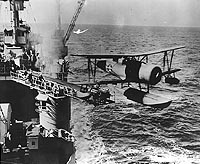 |
|
Photo #: 80-G-30118 North African Campaign, November 1942 A Curtiss SOC "Seagull" scout-observation aircraft drops a message as it flies over USS Augusta (CA-31), during operations off North Africa in November-December 1942. Note the message capsule that has just been tossed out by the plane's observer. Official U.S. Navy Photograph, now in the collections of the National Archives. Online Image: 37KB; 740 x 610 pixels Reproductions of this image may also be available through the National Archives photographic reproduction system. |
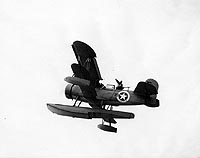 |
|
Photo #: NH 81995 Curtiss SOC-3 "Seagull" floatplanes Fly in a formation of four, circa 1944. These aircraft are from USS Portland (CA-33). Courtesy Vice Admiral T.G.W. Settle, USN (Retired), 1975. U.S. Naval History and Heritage Command Photograph. Online Image: 56KB; 740 x 600 pixels |
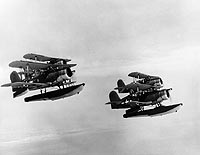 |
|
Photo #: NH 81996 Curtiss SOC-3 "Seagull" floatplanes Fly in a formation of four, circa 1944. These aircraft are from USS Portland (CA-33). Courtesy Vice Admiral T.G.W. Settle, USN (Retired), 1975. U.S. Naval History and Heritage Command Photograph. Online Image: 43KB; 740 x 615 pixels |
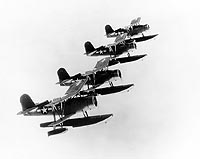 |
For further views of SOC aircraft, see:
NOTES:
| If you want higher resolution reproductions than the digital images presented here, see: "How to Obtain Photographic Reproductions." |
Page made 21 April 2001
Coding updated 7 May 2009